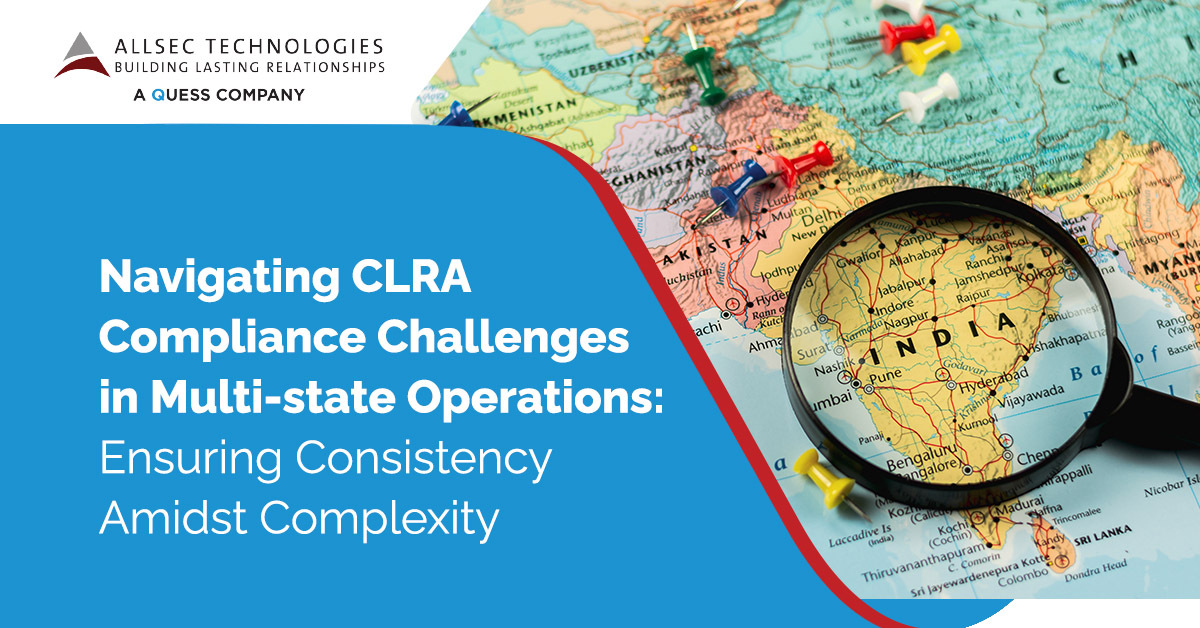
For businesses operating in multiple states in India, the payroll compliance landscape can be a complex and daunting task. The Contract Labour (Regulation and Abolition) Act, 1970 (CLRA) which governs the employment of contract labourers, ensures their welfare and regulating labour-related practices. However, maintaining consistent CLRA compliance across different jurisdictions poses significant challenges.
In this blog, we will explore the complexities faced by businesses and provide insights into strategies for unifying compliance practices to ensure adherence to state-specific requirements.
Understanding State-Specific CLRA Requirements
The first step in achieving consistent compliance is to gain a comprehensive understanding of the CLRA requirements specific to each state where your business operates. While the Act provides a framework at the national level, states have the authority to enact their own rules and regulations, leading to variations in compliance requirements. Therefore, it is crucial to conduct a detailed analysis of each state’s CLRA provisions and identify the key differences.
Establishing a Centralized Compliance Team
Develop a team of professionals well-versed in labour laws, familiar with the specific requirements of each state, and capable of ensuring adherence to compliance standards. The centralized team can serve as a focal point for disseminating information, coordinating compliance efforts, and monitoring changes in regulations across different jurisdictions.
Conducting Regular Compliance Audits
Regular compliance audits assess various aspects such as contractor engagement, recordkeeping, wage and hour compliance, health and safety provisions, and overall adherence to CLRA regulations. Thereby, regular audits proactively identify areas of non-compliance and ensure corrective actions are taken promptly.
Implementing Robust Documentation and Recordkeeping Practices
Each state may have specific recordkeeping requirements, such as registers, forms, and registers of contractors. Implementing robust documentation and recordkeeping practices enables businesses to demonstrate compliance during audits and inspections.
Additionally, electronic document management systems can streamline recordkeeping and ensure easy access to relevant information across different locations.
Training and Education
One of the key challenges in maintaining consistent compliance is ensuring that employees and contractors are aware of CLRA requirements and their implications. Businesses should invest in training and education programs to familiarize their workforce with the specific provisions of the act, state-specific requirements, and best practices for compliance. By fostering a culture of compliance, businesses can minimize the risk of violations and non-compliance.
Engaging Local Legal Counsel
Navigating the complexities of multi-state CLRA compliance often necessitates the engagement of local legal counsel who are experienced labour law attorneys that can provide valuable insights into state-specific requirements, interpret complex regulations, and assist in developing compliance strategies. Local legal counsel can also help businesses stay updated with changes in CLRA provisions, ensuring continued adherence to evolving compliance standards.
Leveraging Technology Solutions
Compliance management software and tools can streamline processes, facilitate centralized monitoring, automate recordkeeping, and provide real-time updates on regulatory changes. Technology solutions can enhance efficiency, reduce manual errors, and enable businesses to maintain consistent compliance across different states.
Conclusion
Maintaining consistent CLRA compliance in multi-state operations is a complex endeavour for businesses in India. However, businesses can navigate the complexities and ensure adherence to CLRA regulations by prioritizing compliance and adopting proactive measures. Thereby, businesses can mitigate risks, safeguard the welfare of contract labourers, and foster a culture of ethical and responsible labour practices.


